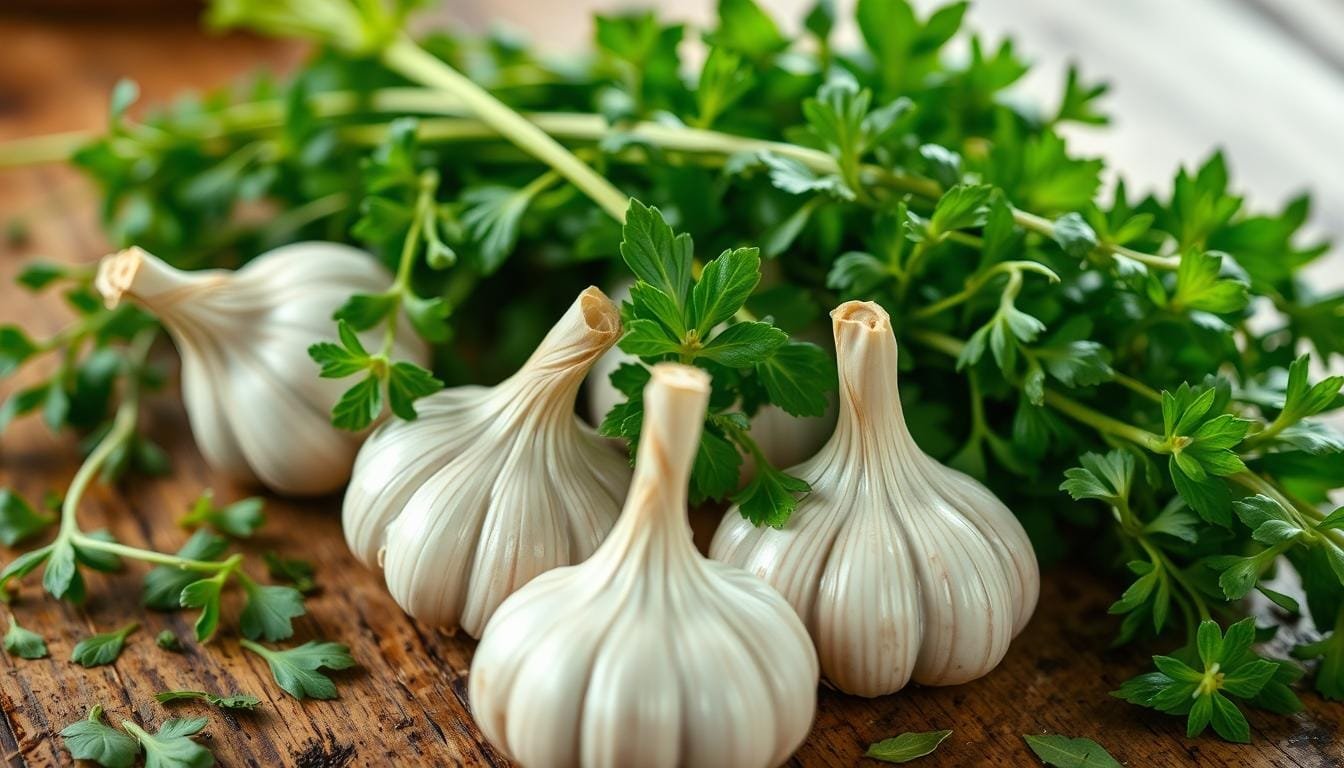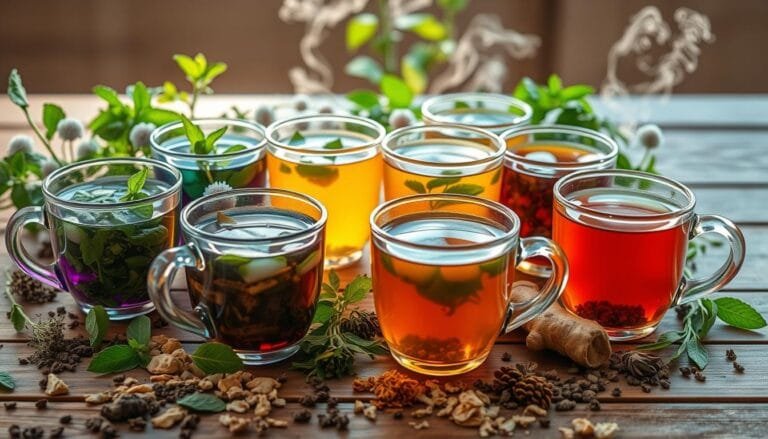I’m passionate about natural health and wellness. Garlic (Allium sativum) is fascinating to me. It’s been a natural remedy for thousands of years. It has compounds like allicin, diallyl sulfide, and S-allyl cysteine that help our health.
Garlic has been used for ages, from ancient times to today. It helps with many health issues, like colds, high blood pressure, and heart disease. It’s also low in calories but packed with nutrients like manganese and vitamin C.
Garlic can be eaten fresh or used in meals. It’s also available as a supplement. It boosts our immune system, lowers blood pressure, and improves cholesterol. This herb is a true natural wonder.
Understanding Garlic’s Ancient Medicinal Heritage
Garlic has been a valued herbal remedy for over 5,000 years. It was used by ancient civilizations like the Egyptians, Babylonians, Indians, and Chinese. The ancient Greek physician Hippocrates, known as the “Father of Medicine,” used garlic to treat many health issues.
Traditional Use Across Ancient Civilizations
Garlic was used to fight infections, improve breathing, and aid digestion. The ancient Egyptians gave it to their workers to boost strength. Greek athletes ate it to get an edge in competitions. Its ability to fight off microbes and viruses has made it a staple in traditional medicine for centuries.
Evolution of Garlic in Modern Medicine
Modern science has explored garlic’s effects on cholesterol, blood pressure, and cancer. Research shows it can lower bad cholesterol by 10-15% and help with blood pressure. It also has antioxidants that might prevent some cancers, like colon cancer.
Cultural Significance in Natural Healing
Garlic is important in many traditional healing practices. It’s seen as protective and purifying, keeping evil spirits away and boosting health. Its role in natural and holistic medicine keeps its legacy alive as a trusted herbal remedy.
“Garlic is one of the oldest cultivated plants in the world, with a rich history as a medicinal and culinary staple.”
Essential Compounds and Nutritional Profile of Garlic
Garlic is known for its taste and health benefits. It’s packed with compounds like allicin, which gives it a strong smell. These compounds also help with health.
Garlic is low in calories but high in nutrients. A small clove has only 4.5 calories. It’s full of manganese, vitamin B6, and vitamin C. It also has selenium, fiber, and small amounts of other minerals.
The garlic bulb has special enzymes. These enzymes help turn garlic’s compounds into active forms. This is how garlic gets its health benefits.
| Nutrient | Amount per 100g of Garlic |
|---|---|
| Calories | 149 |
| Carbohydrates | 33g |
| Protein | 6.4g |
| Fiber | 2.1g |
| Vitamin C | 31.2mg |
| Vitamin B6 | 1.2mg |
| Manganese | 0.5mg |
| Selenium | 14.2mcg |
Garlic is a great addition to any diet. It’s full of nutrients and compounds that help with health.

Benefits of Garlic as Herbal Remedy: A Comprehensive Overview
Garlic is known for its strong smell and taste. It has been used in traditional medicine for centuries. Today, scientists are finding out more about its health benefits. Let’s look at its key effects, active ingredients, and how much to take.
Key Therapeutic Properties
Garlic is good for many health issues. It fights inflammation, kills bacteria, and protects the heart. Studies show it can lower blood pressure, cholesterol, and boost the immune system. It might even help prevent some cancers.
Active Medicinal Components
The main compounds in garlic are organosulfur compounds. These include alliin, allicin, and S-allylcysteine (SAC). They give garlic its smell and taste, and help with health.
About 80% of garlic’s cysteine sulfoxides are alliin. This turns into allicin when garlic is crushed or cut.
Recommended Daily Intake
The right amount of garlic varies based on health goals and current health. Eating 1-2 cloves of fresh garlic or 300-1,000 mg of garlic extract daily is good. But, talk to a doctor before taking garlic supplements. They might affect other medicines or cause side effects.
“Garlic has been used as a medicinal herb for thousands of years, and modern research continues to uncover its remarkable therapeutic potential.
Garlic’s Impact on Immune System Function
Garlic has been known for boosting the immune system and fighting off colds and flu. Recent studies have uncovered how garlic helps the body fight viruses and bacteria.
A study showed that those who took aged garlic extract had milder cold and flu symptoms. They also missed fewer work days than those who didn’t take it. Garlic’s antiviral properties help stop viruses from entering cells or multiplying, lowering the risk of getting sick.
The sulfur compounds in garlic boost the production of white blood cells. These cells are key in fighting off infections. Garlic also helps other immune cells work better, like phagocytosis and cytokine secretion.
“Garlic is a powerful immune booster that can help ward off colds and flu. Its antiviral and antibacterial properties make it a natural remedy worth incorporating into your diet.”
To get the most from garlic, eat it raw or lightly cooked. Letting crushed or sliced garlic sit for 10 minutes before cooking keeps its active compounds. Garlic supplements, like aged garlic extract, are also a good way to add garlic to your diet.
Along with garlic, eating well, staying active, and sleeping enough are key for a strong immune system. Using natural remedies like garlic can strengthen your body’s defenses against common illnesses and improve your overall health.
Heart Health and Blood Pressure Management
Garlic is known for its heart health benefits. It contains compounds like allicin that can lower cholesterol and blood pressure. These are key for a healthy heart.
Cholesterol-Lowering Effects
Studies show garlic can lower total and LDL (“bad”) cholesterol. This is true for people with slightly high cholesterol. Garlic’s compounds may stop the liver from making too much cholesterol.
Cardiovascular Protection Mechanisms
Garlic does more than just lower cholesterol. Its allicin can reduce the hormone that raises blood pressure. This makes blood vessels relax and improves heart function. It may lower the risk of heart disease and stroke.
Blood Pressure Regulation
Many studies prove garlic can lower blood pressure in people with hypertension. Its effects are similar to some prescription drugs. This makes garlic a natural and affordable way to manage high blood pressure.
Adding garlic to your diet or taking supplements can boost your heart health. Always talk to your doctor before making any changes. They can help you choose the best option for your health.
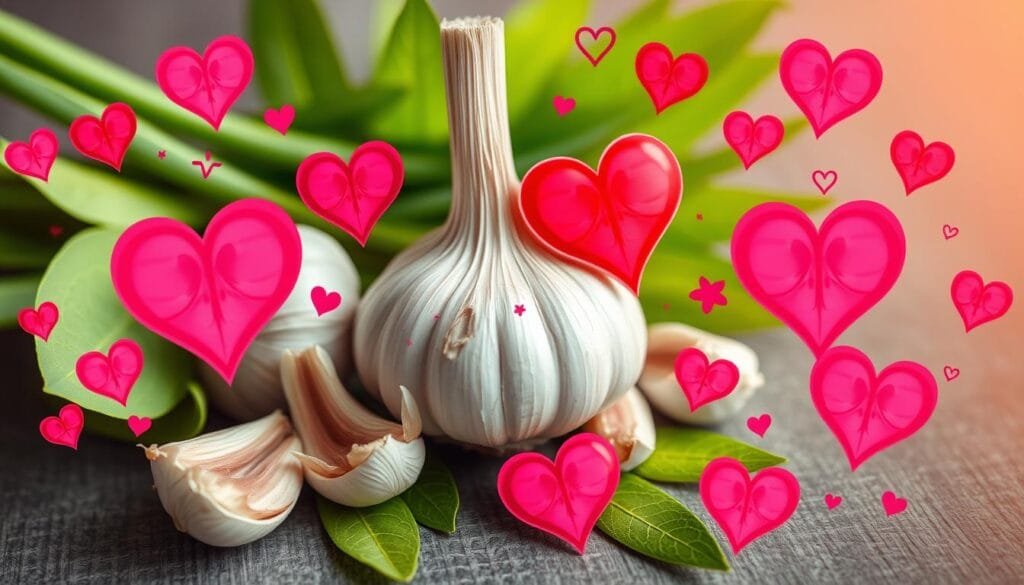
“Garlic has been historically used as a medicinal agent in various cultures dating back to ancient civilizations, and its cardiovascular health benefits are well-documented.”
Antioxidant Properties and Disease Prevention
Garlic is packed with antioxidants that fight oxidative damage. This can help lower the risk of diseases like Alzheimer’s and dementia. Its antioxidants help the body fight off harmful free radicals and stress.
Recent studies have shown garlic’s amazing antioxidant powers. A review of 83 human trials found garlic can change biomarkers for different diseases. It’s also found that allicin, a key garlic compound, is more available in supplements than in raw garlic.
| Bioactive Compound | Bioavailability |
|---|---|
| Allicin from enteric tablets | 36% to 104% at ≥0.5 h after consumption |
| Allicin from non-enteric tablets | 80–111% higher compared to garlic capsules |
Garlic’s antioxidants aren’t just allicin. It also has compounds like S-allyl cysteine (SAC) and S-allylmercaptocysteine (SAMC). These compounds have long half-lives and are well cleared by the kidneys.
Garlic’s antioxidants might also help us age better and prevent diseases. Animal studies suggest allicin in garlic could protect against brain decline. But, we need more human studies to confirm these benefits.
“Garlic is a treasure trove of antioxidants that can safeguard our health and potentially stave off a range of debilitating diseases.”
Garlic’s Role in Fighting Infections and Bacteria
Garlic is more than just a kitchen staple. It has amazing antimicrobial properties. Its active compound, allicin, is a strong antibiotic. It fights bacteria, fungi, and viruses.
Studies show garlic can fight antibiotic-resistant bacteria. This gives hope in the fight against tough infections.
Antimicrobial Properties
The allicin in garlic is key to its antimicrobial power. It breaks down the cell walls of harmful microbes. This stops them from growing and spreading.
Garlic works against many bacteria, even those resistant to antibiotics. Adding garlic to your diet or taking supplements can help fight off infections.
Antifungal Benefits
Garlic is also good against fungi. It can help with candida overgrowth, a common fungal infection. The antifungal compounds in garlic balance gut flora.
This stops harmful fungi and helps good microbes grow.
Viral Protection Capabilities
Garlic might also protect against viruses. More research is needed to understand its effects. But, it could boost your immune system and fight off viruses.
Using garlic antibacterial, garlic antifungal, and garlic antiviral properties can improve your health. Adding garlic to your life can boost your wellbeing and fight off infections.
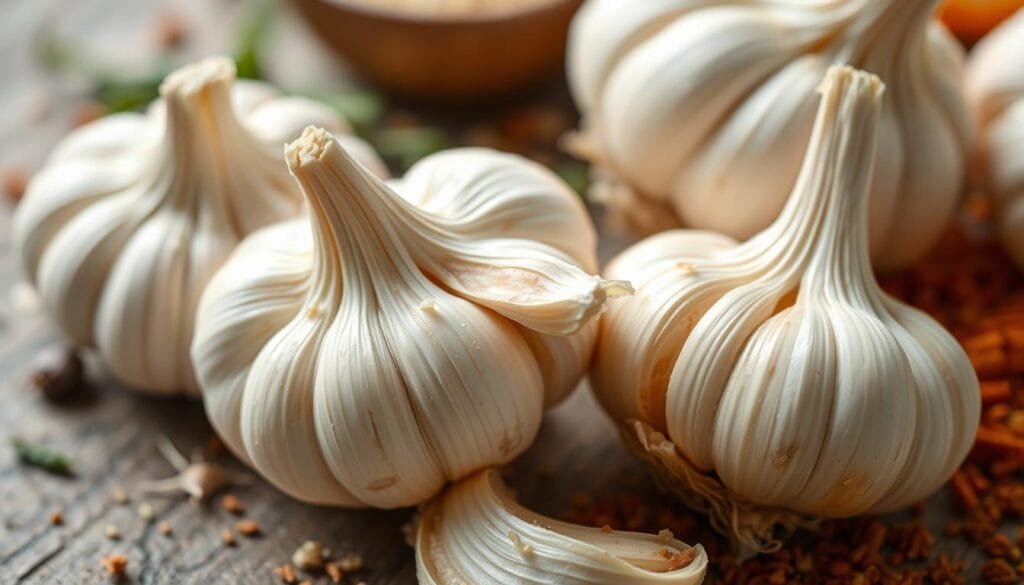
Detoxification and Liver Support Benefits
Garlic is a natural superfood that supports liver health and detoxification. Its sulfur compounds protect the liver from damage, like alcohol harm. This is very important.
Research shows garlic helps the liver fight heavy metal toxicity. A study on car battery plant workers found garlic lowered blood lead levels by 19%. It also improved symptoms.
Garlic may help with liver diseases too. A 2020 study found men eating raw garlic over 7 times a week had a 29% lower risk of fatty liver disease. It also reduced liver cancer risk by 23%.
For people with non-alcoholic fatty liver disease (NAFLD), garlic powder supplements are helpful. Those taking 800 mg daily for 15 weeks saw big improvements. Liver enzymes, LDL cholesterol, and triglycerides all went down.
Garlic is great for detox and liver health. But, always talk to a doctor before using it.
“Garlic’s hepatoprotective properties may help in managing various liver conditions.”
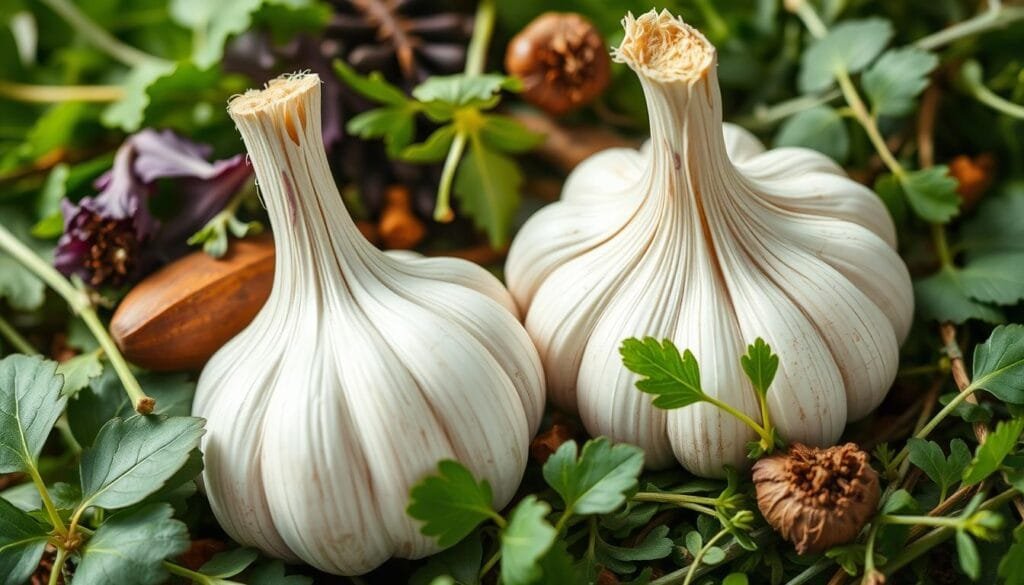
Eating garlic or taking supplements can help your liver. It’s a simple way to keep your body healthy.
Methods of Consumption and Preparation for Maximum Benefits
Garlic is a versatile ingredient with many health benefits. It can be eaten in different ways, but raw garlic is thought to be the most beneficial. Cooking garlic can reduce some of its good compounds.
To keep garlic’s benefits, chop or crush it and let it sit for a few minutes before cooking. This helps keep its allicin and other medicinal compounds.
If you don’t like the taste or smell of fresh garlic, garlic supplements are a good option. They come as powders, oils, or aged garlic extracts. Each type has its own benefits and uses.
Choosing between raw garlic in your meals or supplements depends on your taste and health goals. The effects of garlic can change based on how you prepare and eat it.
Exploring different ways to use garlic in your diet is key. Try raw, cooked, or supplements to find what works best for you.
